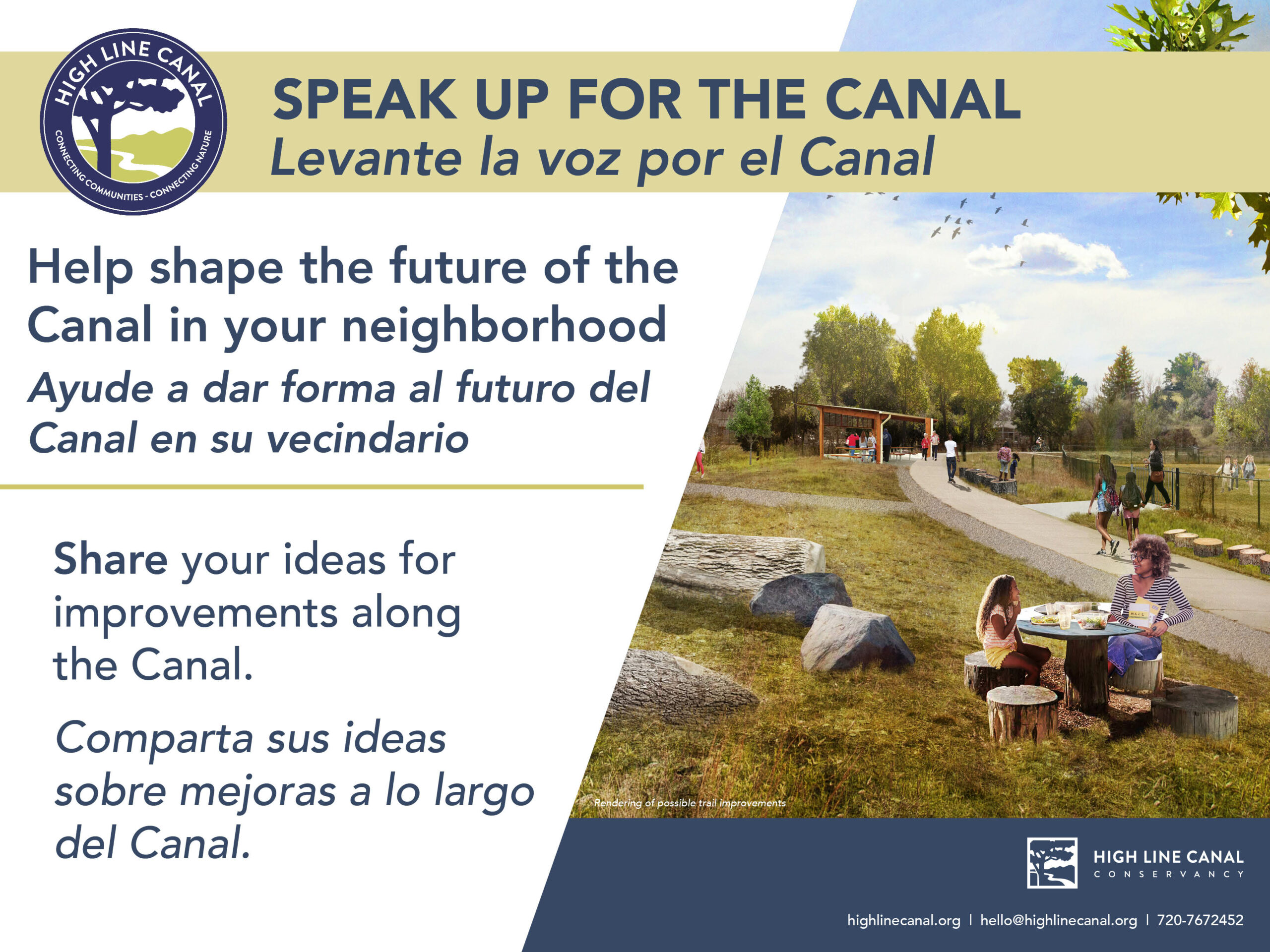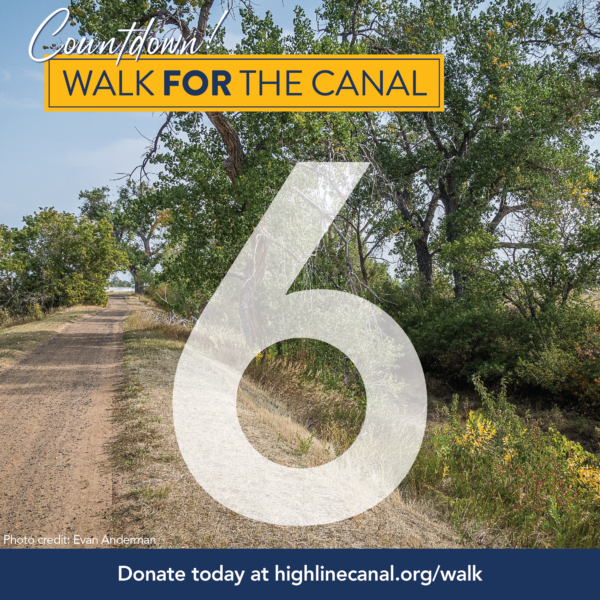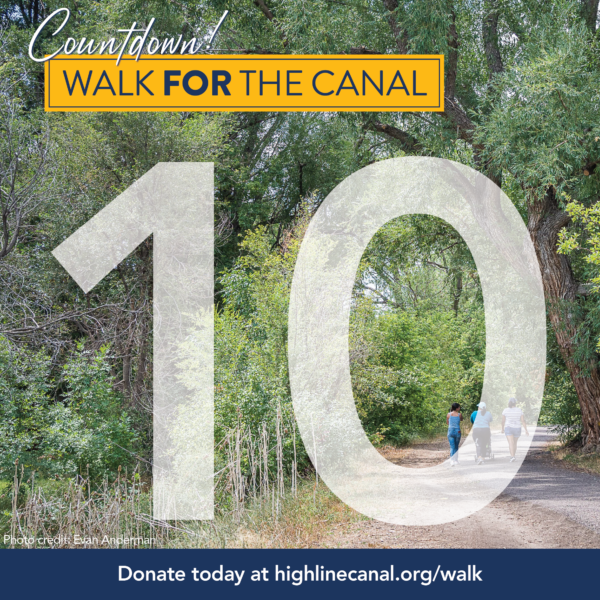Overview
The High Line Canal serves as a natural escape for over a million trail users each year and is a 71-mile ecological corridor that plays an important role in supporting biodiversity for the region’s wildlife and vegetation. As part of a comprehensive, long-term plan to strengthen the environmental health and resilience of the corridor, the Conservancy and Canal Collaborative partners are committed to revitalization efforts, including planting more than 3,500 trees along the Canal over 15 years. Since 2019, 450 trees have already been planted along the corridor, and the Conservancy and Denver Water are working on high-priority natural resource restoration along all 71 miles of the Canal over the next two to three years. This coordinated effort will improve trail user experience and environmental health by pruning and removing hazardous and dying trees, mitigating potential impacts of the Emerald Ash Borer, clearing debris from the Canal channel, removing invasive trees, and planting new vegetation.
Tree Canopy Care
Recently, the Canal Collaborative completed the first Canal-wide tree risk assessment to better understand tree pruning and removal needs on the corridor. The assessment built on a tree inventory completed in 2016, collecting detailed information about the condition of the tree canopy. In total, the assessment collected updated data on over 8,500 trees larger than 12” diameter along the Canal corridor. During the assessment, arborists evaluated the health of trees and recommended actions to mitigate risk. Significant tree canopy care work will be ongoing in 2024 and 2025 to address the highest priority prunes and removals recommended to maintain a safe trail environment.
Russian Olive Removal
Russian olive is an invasive species that displaces native vegetation and degrades the ecological health of the Canal. In 2021, the Conservancy launched a program to remove Russian olive along the corridor in partnership with Mile High Youth Corps. The Conservancy has secured grant funding from Great Outdoors Colorado to continue working with Mile High Youth Corps to remove Russian olive on the Canal in 2024. Read more about invasive species removal here.
Emerald Ash Borer Mitigation
Emerald Ash Borer (EAB) is an invasive beetle that infests and kills ash (Fraxinus spp.) trees. In summer 2023, EAB was confirmed in Littleton near the border with Englewood, Greenwood Village and Centennial. Ash are the second most common tree species along the Canal’s corridor, making up 16% of trees over 6 inches in diameter along the Canal. The Conservancy and our partners are implementing a two-pronged approach to mitigate the impact of EAB on the Canal:
- Large, healthy ash will be treated with insecticide to protect them from the borer, and
- Unhealthy ash will be proactively removed from the corridor.
Learn more about EAB from Arapahoe County or Denver Parks and Recreation.
Debris Removal
The Canal is in a time of transition as the primary function of the channel shifts from irrigation delivery to green stormwater infrastructure. Managing stormwater in the Canal provides a host of ecological benefits by helping to improve water quality and support the corridor’s plant community. With stormwater flowing in the Canal, the buildup of brush and debris can create a flood risk when large accumulations collect in the channel. Debris can also create standing pools of water in the Canal channel, providing habitat for mosquitos to breed. To address these concerns, crews will remove large woody debris from the channel, beginning in areas with significant stormwater flows.
Frequently Asked Questions
When will the maintenance begin?
This initial tree care and debris removal effort is expected to begin in early 2024 and anticipated to continue through 2025. Continued tree care will take place along the Canal in perpetuity.
Where will the maintenance take place?
This collaborative maintenance effort will help enhance the Canal in every jurisdiction. Check the Trail Notices & Detours page to stay up to date on any closures that may impact your travel along the trail.
How will maintenance affect Canal users?
Crews working along the Canal will do their best to minimize disruptions along the trail while removing trees and debris. However, trail closures may be necessary in some areas. Stay up to date on any closures by checking the Trail Notices & Detours page and following the Conservancy on social media.
How is this maintenance program funded?
This natural resource maintenance project is possible because of joint funding from the Conservancy and Denver Water. The Conservancy is committed to working with its partners to advance maintenance and restoration projects along the Canal and elevate the level of care on the corridor. Learn how to get involved and support the Conservancy’s work to steward the Canal’s natural resources.
What maintenance has been completed to date?
With over 23,000 mature trees along the corridor, continuous care and maintenance is required to steward the Canal’s canopy and ensure a safe and vibrant trail corridor. Since 2018, over 1,000 unhealthy trees have been pruned or removed from the corridor.
Why are trees being removed?
The 71 miles of Canal are home to over 23,000 mature trees, making the Canal a vital component of the region’s urban forest. This Canal is in a time of transition as Denver Water reduces its reliance on the Canal for irrigation delivery, aging cottonwoods reach the end of their natural lifespans, and local jurisdictions manage the Canal more proactively for both recreation and stormwater management. The composition of the tree canopy is reflective of the Canal’s historic use for irrigation delivery, when the Canal was filled with water for upwards of six months out of the year. As a result, the mix of trees on the Canal is primarily riparian, with cottonwoods making up 43% of mature trees and willows making up another 8%. Over 90% of trees recommended for removal or pruning in this maintenance effort are riparian species that established on the Canal decades ago when frequent irrigation deliveries allowed the human-made Canal to mimic a natural waterway. With less water in the region and in the Canal, these trees are declining and need to be pruned or removed to maintain a safe trail environment.
Will new trees be planted along the Canal?
As many of these cottonwoods near the end of their lifespan and become stressed by low water availability, it is crucial that new trees are planted along the corridor to revitalize the canopy for years to come. To this end, The Plan for the High Line Canal recommends planting 3,500 trees, or 50 trees per mile on average, along the Canal corridor over 15 years. The Conservancy and partners in the Canal Collaborative are working together to implement tree planting projects and together, we have planted over 450 trees since 2019. Read more about the Conservancy’s tree planting program.
Who do I contact for more information?
If you have any questions about this maintenance program, please email hello@highlinecanal.org or call us at (720) 767-2452.







